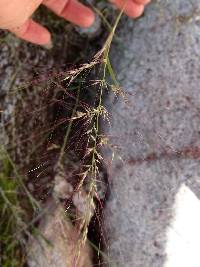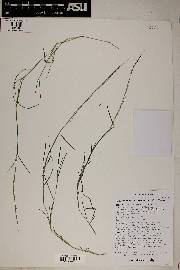|
Family: Poaceae
littleseed muhly
[Muhlenbergia debilis (Kunth) Kunth] |
Plants annual, sometimes appearing as short-lived perennials; tufted. Culms10-80 cm, often geniculate at the base, much branched near the base; internodes mostly scabridulous or smooth, always scabridulous below the nodes. Sheaths often shorter than the internodes, glabrous, smooth or scabridulous; ligules 1-2 mm, membranous to hyaline, truncate to obtuse; blades 3-8.5(10) cm long, 1-2.5 mm wide, flat or loosely involute, scabrous abaxially, strigulose adaxially. Panicles 6.5-13.5 cm long, 1-6.5 cm wide, not dense, often purplish; branches 1.6-4 cm, ascending or diverging up to 80° from the rachises, spikelet-bearing to the base; pedicels 2-6 mm, appressed to divaricate, antrorsely scabrous; disarticulation above the glumes. Spikelets 2.5-5.5 mm, borne singly. Glumes 0.4-1.3 mm, exceeded by the florets, 1-veined, obtuse, often minutely erose; lower glumes 0.4-1 mm; upper glumes 0.6-1.3 mm; lemmas 2.5-3.8(5.3) mm, narrowly lanceolate, mostly smooth, scabridulous distally, hairy on the calluses, lower 1/2 of the margins, and midveins, hairs 0.2-0.5 mm, apices acuminate, awned, awns 10-30 mm, straight to flexuous; paleas 2.2-4.8 mm, narrowly lanceolate, acuminate; anthers 0.3-1.2 mm, purplish. Caryopses 1.7-2.5 mm, fusiform, reddish-brown. Cleistogamous panicles with 1-3 spikelets present in the axils of the lower leaves. 2n = 20, 40, 60.
Muhlenbergia microsperma grows on sandy slopes, drainages, cliffs, rock outcrops, and disturbed roadsides, at elevations of 0-2400 m. It is usually found in creosote scrub, thorn-scrub forest, sarcocaulescent desert, and oak-pinyon woodland associations. Its range extends from the southwestern United States through Central America to Peru and Venezuela. Morphological variation among and within its populations is marked.
FNA 2003, Gould 1980 Common Name: littleseed muhly Duration: Annual Nativity: Native Lifeform: Graminoid General: Soft and delicate annual grass with weak erect or spreading stems, 10-70 cm long, much-branched at lower nodes, often suffused with purple, often growing through other plants. Vegetative: Sheaths shorter than internodes, glabrous or scabrous; blades scabrous to pilose with short hairs, flat, 1-8 cm long, soon drying and early deciduous; ligules membranous, translucent white, 1 mm long, decurrent. Inflorescence: Panicles numerous, narrow, loosely flowered, 5-20 cm long; branches usually ascending or spreading but appressed in early stages, usually purplish; spikelets on short, rather stout, scabrous, spreading pedicels; glumes short and broad, covering only base of lemma; body of lemma narrow, 2 mm, tapering into slender awn 15-30 mm, easily opening to release golden-brown caryopsis. Ecology: Found on rocky slopes, in canyons, and other favorable microsites below 5,000 ft (1524 m); flowers March-August. Distribution: sw. US in s. CA, s. NV, AZ and sw. UT, south through C. Amer. to Peru and Venezuela Notes: Muhlenbergia is a large and diverse genus primarily distinguished by having single-flowered spikelets with unequal glumes. This species is a delicate annual, distinct by its long, weak much-branched stems tending to grow through other plants, and its tiny long-awned seeds. Similar to M. appressa and M. tenuifolia, but both of those species have contracted panicles, while M. microsperma has ascending (not apressed) panicle branches and somewhat divergent pedicels. Like many annuals in the Sonoran Desert, this species is fast-growing and quite responsive to moisture. Ethnobotany: Unknown Etymology: Muhlenbergia is named for Gotthilf Heinrich Ernst Muhlenberg (1753-1815) a clergyman and botanist from Pennsylvania; microsperma means small seed. Synonyms: Muhlenbergia debilis Editor: SBuckley 2010, AHazelton 2015 |



